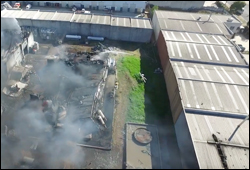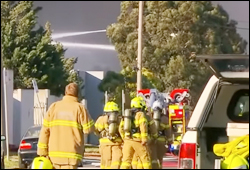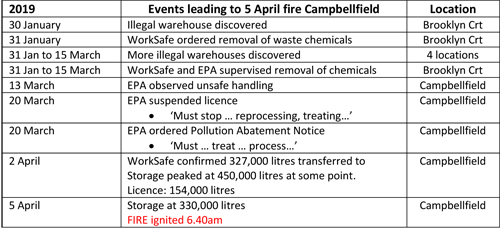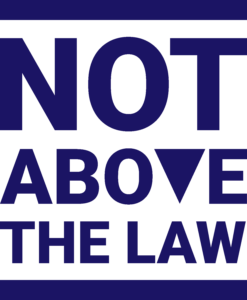Chemical Fire 2019
13 November 2022
[PDF version of this page is here]
Overview
On 5 April 2019 a chemical storage and processing warehouse in the north-western suburb of Campbellfield in Melbourne (the Campbellfield facility) erupted into flames (the fire). The fire was a toxic inferno that took several days to extinguish, putting at critical risk the health and safety of workers, firefighters, other emergency response personnel and community members. Warehouse employees and firefighters were injured.
The fire was a direct result of the conduct of the Worksafe Authority of Victoria and the Environment Protection Authority of Victoria (EPA).
Self-Employed Australia has issued a Section 131 notice (under the Occupational health and Safety Act of Victoria) to the WorkSafe Authority of Victoria requiring WorkSafe to:
- Prosecute the EPA; and
- For WorkSafe Victoria to prosecute itself
for breaches of the Occupational Health and Safety Act (Vic) in relation to the fire.
The evidence is unequivocal that both WorkSafe and the EPA:
- Knew that the Campbellfield facility had exceeded its legal limit for the storage of dangerous chemicals by some 300 per cent, thereby creating the fuel for the massive fire.
- Allowed, sanctioned and ordered the storage of illegal quantities of dangerous chemicals at the facility.
- Were complicit in ordering, allowing and supervising the transport of dangerous waste chemicals to the facility to the extent that the facility exceeded its legal licensed limit by a multiple of three.
- Ordered the Campbellfield facility to process the dangerous chemicals even though it issued a conflicting order to stop processing. It was this processing that directly caused the fire.
The evidence irrefutably establishes breaches of the OHS Act and demands the prosecution of the EPA and WorkSafe. The issue of the Section 131 notice by SEA obligates WorkSafe under the OHS Act to investigate with a view to prosecuting. It is for the courts to decide if WorkSafe and/or the EPA are guilty.
This paper summarises the circumstances of the fire, focusing on the actions and failures of the EPA and WorkSafe that put at risk the health and safety of workers (employees), firefighters, other emergency response personnel and community members.
This paper draws on:
- Source documents made available in the public domain on 30 September 2022 following the finalisation of a court action related to the fire.
- Evidence delivered to the 2019 Victorian Upper House Inquiry into the management of dangerous waste chemicals in Victoria—specifically the evidence in relation to the fire.
- Media coverage at the time
The court-released documents are particularly important as they are the missing parts of the jigsaw that enable a conclusion and opinion to be formed as to the culpability of the EPA and WorkSafe in relation to breaches of the OHS Act to the extent that the EPA and WorkSafe should be prosecuted.
Facts and timelines leading to the fire
1 Bradbury
- Bradbury Industrial Services Pty Ltd (Bradbury) ran an industrial waste storage and processing business.
 2 Campbellfield Facility: Warehouse and Processing – Site of the fire
2 Campbellfield Facility: Warehouse and Processing – Site of the fire
- The Campbellfield facility was Bradbury’s main facility. It was a warehouse in Thornycroft St, Campbellfield, a north-western suburb of Melbourne.
- This site not only stored waste chemicals but it also processed waste chemicals into fuel that could be burnt in specific types of furnaces. The site had an EPA licence to store up to 154,000 litres of waste chemicals.
3 Risk Equation
- Waste chemicals are commonly stored and transported in Intermediate Bulk Containers (IBCs) each of which can hold 1,000 litres of fluid.
- The EPA issues licences for the storage, transport, handling and processing of waste chemicals based on risk assessments.
- Warehouses that simply store IBCs of waste chemicals have a lower risk (of fire, etc) than warehouses that both store and process waste chemicals. The processing of waste chemicals is varied, but all involve the moving, pouring and handling of waste chemicals into/out of IBCs etc. By its nature processing is higher risk activity than simple warehousing.
4 Bradbury’s Five Illegal Warehouses
- Between 30 January 2019 and 15 March 2019, the EPA and WorkSafe discovered that Bradbury had five warehouses in which waste chemicals were stored illegally.
- Those sites were: (1) 9-11 Brooklyn Court, Campbellfield; (2) 20A, (3) 20B and (4) 12 Yellowbox Drive, Craigeburn; and (5) 15/1745 Sydney Rd, Campbellfield.
- In all, there were some 11 million litres of illegally stored waste chemicals across the five sites. Bradbury did not have licences to store waste chemicals at any of these five warehouses.
 5 EPA and WorkSafe order moving of waste chemicals
5 EPA and WorkSafe order moving of waste chemicals
- Upon the discovery of the five illegal warehouses, the EPA and WorkSafe focused on having the chemicals removed from those warehouses. The first warehouse discovered was 9/11 Brooklyn Court, Campbellfield. The EPA and WorkSafe issued orders to Bradbury to remove the illegal waste chemicals from Brooklyn Court. Effectively, from 31 January 2019, the EPA and WorkSafe exercised control over the Bradbury operations.
Evidence from court document:
- Paragraph 16. 31 January: WorkSafe issued an Improvement Notice that ‘stipulated that all of the Brooklyn Court IBCs were to be removed from Brooklyn Court…’
Source: Doc A1—Affidavit of John Keramidas (Bradbury manager) - Chemicals from Brooklyn Court were transported to three legal sites. Two of the sites were non-Bradbury-owned warehouses. The third site was the Bradbury-owned and run Campbellfield facility, the site of the fire.
- Both the EPA and WorkSafe ordered, supervised and oversaw the transport of the waste chemicals to the three legal sites, including the Campbellfield facility. The EPA and WorkSafe exercised control over Bradbury in this chemical transfer.
Evidence from court documents:
- Paragraph 44. ‘At points in time (per the relevant entry reports) a representative of WorkSafe and or the EPA was present observing the process including the labelling of the Brooklyn Court IBCs, the labelling of the trucks for transportation, completion of the manifests and the loading of the trucks for delivery…’
- Paragraph 48. ‘On 13 March 2019 I responded to the EPA advising that Bradbury were currently acting under the instructions of WorkSafe Victoria …’
Source: Doc A1—Affidavit of John Keramidas (Bradbury manager)
6 EPA and WorkSafe knew of the risk
The EPA and WorkSafe knew that the storage of the waste chemicals was highly risky and that many IBCs were in an unsafe and dangerous condition.
Evidence from court documents:
- Page 1,235. WorkSafe Entry Report, 31/1/2019 – 9-11 Brooklyn Court
- ‘It is my belief that there is a risk to the health and safety of persons and property due to the inappropriate storage of dangerous goods class 3 … 2134 IBC’s…..shows signs of previous leakage from valves and one IBS was bulging with the potential to split…’
Page 1,240. (Brooklyn Court) ‘…I observed IBC containers that bulged, top screw cap loose and partially collapsed…’ - Page 1,264. WorkSafe Entry Report 1/2/2019 – 9-11 Brooklyn Court
‘I observed approximately >2 million L of dangerous goods of class 3 flammable liquid ……there is a risk of injury to emergency services personnel…’ - Page 1,275. WorkSafe Improvement Notice – 9-11 Brooklyn Court
‘… emergency response service personnel may be exposed to increased risk…’
Source: Doc A1—Affidavit of John Keramidas (Bradbury manager)
7 EPA and WorkSafe knew of unsafe handling at the Campbellfield facility
WorkSafe and the EPA knew that waste chemicals were being handled in an unsafe manner at the Campbellfield facility having directly observed unsafe handling.
Evidence from court document:
Page 1,344. EPA Inspection Report, 13/3/2019, 16/18 Thornycroft Street
- Page 1,345. ‘Observed trucks with chemicals and waste being unloaded in an unbunded area at the premises.’ (non-compliance with licence)
‘Observed a pallet with five of 4 litre plastic containers labelled Class 8 corrosive liquid including phosphoric acid solution and hydrofluoric acid.’ (non-compliance with licence)
‘It was estimated that approximately 450,000 of liquid waste was being stored at the premises …’ (non-compliance with licence)
Source: Doc A1—Affidavit of John Keramidas (Bradbury manager)
 8 EPA and WorkSafe ordered and were involved in the transfer of dangerous chemicals to Campbellfield facility
8 EPA and WorkSafe ordered and were involved in the transfer of dangerous chemicals to Campbellfield facility
Both the EPA and WorkSafe knew the quantity and dangerous nature of the chemicals being transported to the Campbellfield facility.
Further, the EPA and WorkSafe were aware that the quantities being transferred would have led the Campbellfield facility to exceed its legal licence limit.
Evidence from court document:
- Page 1,485. WorkSafe Entry Report, 9-11 Brooklyn Court, 2/04/2019
I was informed by General Manager ….that 2,134 IBC’s were relocated to the following
1007 IBC’s transported to ……..
800 IBC’s transported to ………
327 damaged IBCs were returned to Bradbury Industrial Services (Thornycroft Street)
Source: Doc B1—WorkSafe Entry Report
327 IBCs is 327,000 litres of chemical waste. The transfer of this waste put the Campbellfield facility in breach of its licence limit (of 154,000 litres). This resulted in a peak storage of 450,000 litres, reduced to 330,000 litres on the day of the fire. The EPA and WorkSafe knew of this transfer. Further, the transfer of chemicals was done in ‘damaged’ IBCs that would have escalated the risk factor at the Campbellfield facility. This transfer was signed off as complete three days before the fire.
The transfer of dangerous chemicals to the Campbellfield facility occurred after the licence was suspended. This suspension was supposed to prevent any further chemicals being transferred to the Campbellfield facility.
Evidence from Parliamentary Inquiry:
- Page 5. Dr Wilkinson (CEO EPA) “….we moved immediately to issue a notice of suspension of licence. That is a very strong regulatory tool. It effectively means that they cannot accept any more material at that site until it comes into compliance.
Source: Doc E1—Victorian Parliament Upper House Inquiry into recycling and waste management, Transcript, 3 May 2019
WorkSafe/EPA ordered the transfer of the dangerous waste chemicals to the Campbellfield facility (see 5 above).
9 EPA and WorkSafe suspended Bradbury’s licence at the Campbellfield facility but ordered processing to continue
On 20 March 2019 the EPA issued Bradbury with two directly conflicting orders.
The first suspended Bradbury’s licence—specifically requiring Bradbury to stop (re)processing or treating the waste chemicals.
Evidence from court documents:
- Page 1,411. EPA Notice of Suspension of licence, 20/3/2019, 16-18 Thornycroft St
‘You must stop discharging, emitting, depositing, reprocessing, treating, storing, containing, disposing or handling waste or substance which are a danger or potential danger to the environment.’…‘This notice takes effect immediately.’
Source: Doc A1 & A2—Affidavit of John Keramidas (Bradbury manager) [emphasis added]
The second (a Pollution Abatement Notice) ordered and required Bradbury to treat and process the dangerous waste chemicals.
Evidence from court documents:
- Page 1,439. Pollution Abatement Notice, 20/3/19 Thornycroft St
- ‘3.2 By 28 June 2019 you must assess, treat, dispose or recycle the waste that is currently stored at the premises ….’
- ‘3.10 You must ensure that all unloading, loading, processing, storage and general handling of contaminated water, prescribed industrial waste, oils and chemicals must be conducted …’
Source: Docs C2 & C3: Court Book [emphasis added]
That is, the processing of the dangerous waste chemicals (that resulted in the fire) was occurring under the direct and specific orders and instructions of the EPA even though the EPA had suspended Bradbury’s licence, ordering that reprocessing and treatment of the dangerous chemicals “must stop”.
10 EPA and WorkSafe ordered the processing to save the State money
The EPA asserted that the reason for allowing the Campbellfield facility to continue to (re)process the dangerous chemicals was so the state government did not have to pay for the processing.
Evidence from Parliamentary Inquiry:
- Page 19. ‘The CHAIR: Can you take me through why, because to me if the licence is suspended, the place should have shut down and been made safe instead of continuing to operate.’
- ‘Dr WILKINSON (CEO EPA): … In suspending their licence, …. you can no longer receive any additional material from other parties to process, but you are obliged to process the excess material you already have on site’…
- ‘and we make those sorts of judgements, because if they do not process that, then public money would be needed to do that, and they have the facilities there….’
Source: Doc E1—Victorian Parliament Upper House Inquiry into recycling and waste management, Transcript, 3 May 2019 [emphasis added]
11 EPA and WorkSafe controlled the Campbellfield facility
The EPA and WorkSafe work closely together supporting each other’s decisions and actions. Together the two organisations controlled the Campbellfield site.
Evidence from Parliamentary Inquiry
- Page 6. Dr WILKINSON (CEO EPA): …When we issued the suspension of licence we notified WorkSafe of that, and we obviously work very closely together with the other agencies. We have a memorandum of understanding with WorkSafe…
- Page 19. Dr WILKINSON (CEO EPA): …and we make those sorts of judgements, because if they do not process that, then public money would be needed to do that, and they have the facilities there. The issue is that we said, ‘Until you do that, you cannot take one single additional IBC through the door from other people, no matter what those contracts …
Source: Doc E1—Victorian Parliament Upper House Inquiry into recycling and waste management, Transcript, 3 May 2019 [emphasis added]
12 Timeline

13 Conclusion from Evidence
Based on the evidence from EPA and WorkSafe documents (available since 30 September 2022), combined with other relevant evidence it is clear that the EPA and WorkSafe put at risk the health and safety of workers (employees), firefighters, other emergency response personnel and community members to the extent that the EPA and WorkSafe were in breach of their obligations and responsibilities under the OHS Act.
They did this by:
- Taking control of the operations of the Campbellfield facility.
- Ordering, overseeing and supervising the transfer of dangerous waste chemicals to the Campbellfield facility thus causing the Campbellfield facility to exceed its legal licence limit. This was done in contravention of the EPA’s own order that chemicals should not be transferred to the Campbellfield facility.
- Ordering the processing and treatment of dangerous waste chemicals at the Campbellfield facility in contravention of the EPA’s own order to stop the processing and treatment of dangerous waste chemicals.
Why the court evidence was only available from 30 September 2022
Following the discovery of the illegal Bradbury warehouses between 30 January 2019 and 15 March 2019, the EPA and WorkSafe took control of the Bradbury operations by issuing notices ordering Bradbury to do certain things. In the case of the first discovered illegal warehouse at Brooklyn Court, Bradbury had to remove illegal waste chemicals to legal warehouses. Bradbury approached David Barry Logistics (DBL) who ran a legal warehouse in Dandenong. DBL agreed to receive 800 IBCs where Bradbury would pay for the storage.
After the fire at Campbellfield, Bradbury went into liquidation and the state government took responsibility for the clean-up. However, the state government refused to pay for the clean-up of the waste chemicals now stored at DBL. The estimated cost to DBL was around $1 million—an amount that would have caused DBL (a family company) to go broke. DBL took the state government to court and on 13 December 2021 the court ordered the state government to pay for the cost of the removal and treatment of the waste chemicals stored at DBL. In its action DBL relied on evidence (particularly EPA and WorkSafe documents) produced during the trial.
Following the court judgment of 13 December 2021, the Supreme Court oversaw arrangements between the state government and DBL in the implementation of the judgment. These arrangements were finalised on 30 September 2022. That is the court action was finally complete on 30 September 2022. This enabled the release of the court documented evidence into the public domain and available for viewing and analysis.
Links to References
The relevant evidence to support the Section 131 application is as follows. The links are to original public domain sources which have now been placed on the SEA website for ease of reference.
A1 Affidavit John Keramidas
https://selfemployedaustralia.com.au/Downloads/NATL/Chemical-Fire-2019/A1-Affidavit-John-Keramidas.pdf
A2 EPA Suspension of Licence
https://selfemployedaustralia.com.au/Downloads/NATL/Chemical-Fire-2019/A2-EPA-Suspension-of-Licence.pdf
B1 Worksafe Transfer of Chemicals
https://selfemployedaustralia.com.au/Downloads/NATL/Chemical-Fire-2019/B1-Worksafe-Transfer-of-Chemicals.pdf
C1 David Barry Logistics vs State of Victoria
https://selfemployedaustralia.com.au/Downloads/NATL/Chemical-Fire-2019/C1-David-Barry-Logistics-vs-State-of-Victoria.pdf
C2 Court Book (DBL vs State of Victoria)
https://selfemployedaustralia.com.au/Downloads/NATL/Chemical-Fire-2019/C2-Court-Book-(DBL-vs-State-of-Victoria).pdf
C3 EPA Pollution Abatement Notice
https://selfemployedaustralia.com.au/Downloads/NATL/Chemical-Fire-2019/C3-EPA-Pollution-Abatement-Notice.pdf
D1 Finalisation David Barry Logistics vs State of Victoria
https://selfemployedaustralia.com.au/Downloads/NATL/Chemical-Fire-2019/D1-Finalisation-David-Barry-Logistics-vs-State-of-Victoria.pdf
E1 EPA Evidence Victorian Parliamentary Inquiry
https://selfemployedaustralia.com.au/Downloads/NATL/Chemical-Fire-2019/E1-EPA-Evidence-Victorian-Parliamentary-Inquiry.pdf
F1 EPA Media statement 1 August 2019
https://selfemployedaustralia.com.au/Downloads/NATL/Chemical-Fire-2019/F1-EPA-Media-statement-1-August-2019.pdf


